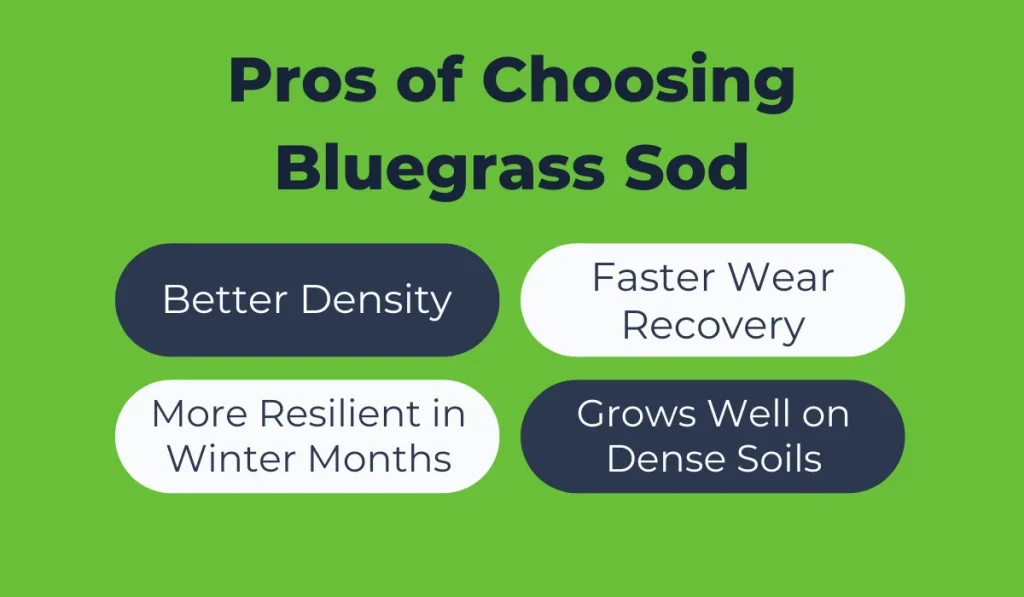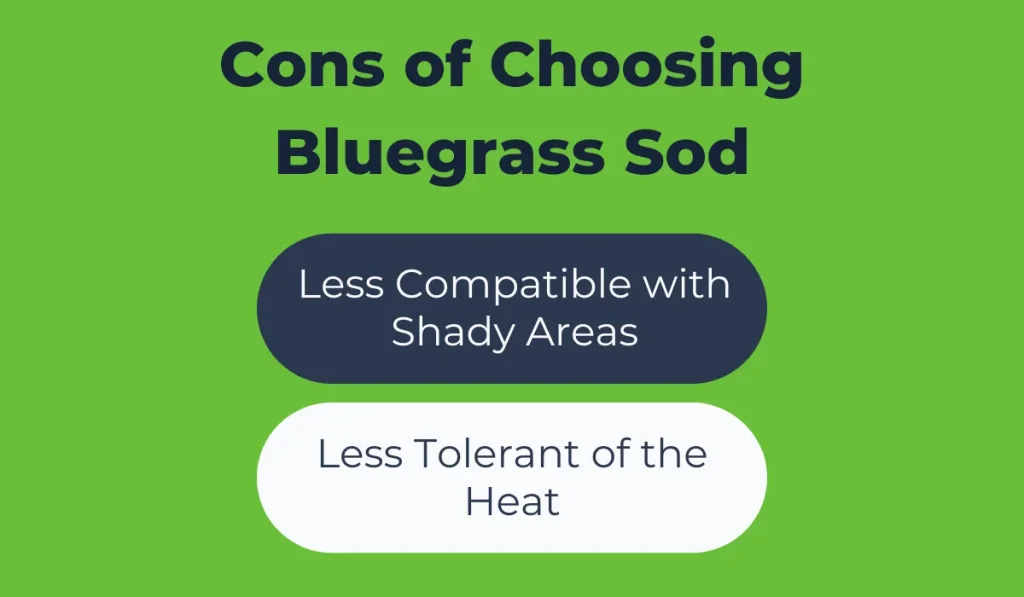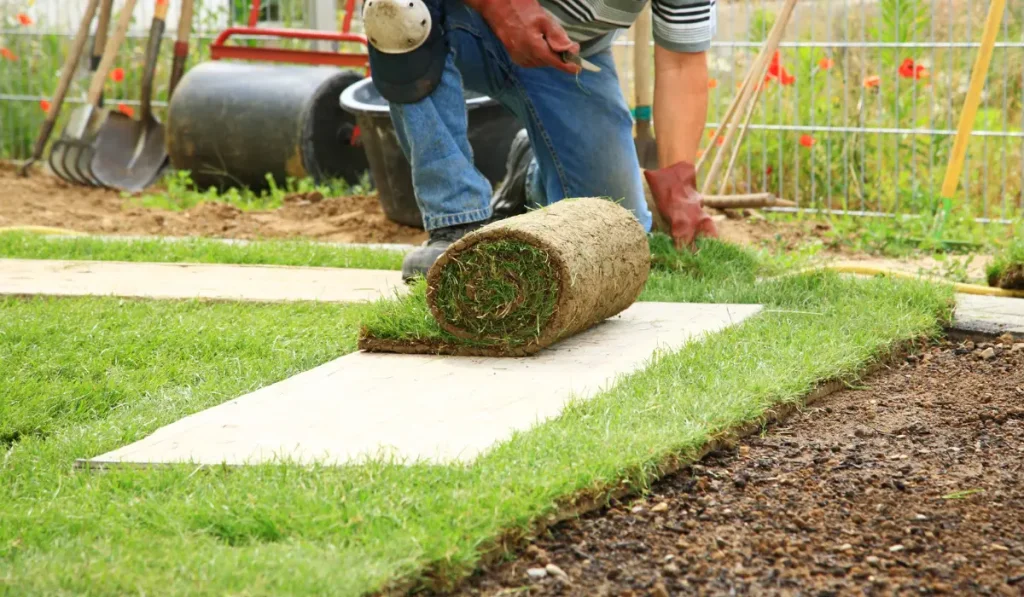When it comes time to choose sod for your lawn, there are a few different options to consider. Each type of sod has its own set of pros and cons, so it’s important to choose the one that will work best for your individual needs.
Bluegrass sod is a popular choice for many homeowners due to its grassy look and durability.
Read on to learn more about the pros and cons of choosing bluegrass sod for your lawn.
Key Takeaways
- If you’re starting a new lawn and live in the cooler northern states, you may want to consider a Kentucky bluegrass lawn with bluegrass sod.
- It is a durable lawn that has excellent wear tolerance, making it the ideal lawn type for playgrounds and sports fields.
- This grass species is a cool-season lawn grass that prefers cool soil temperatures and the cool seasons of fall and spring.
What Is Bluegrass Sod?
Bluegrass sod is a type of grass that is found on many lawns in the United States, particularly in “transition zone” areas where both cool and warm-season grasses will work well.
Composed entirely of Kentucky bluegrass or sometimes used in other blends with other species, like tall fescue or perennial ryegrass, it is a cool-season grass, which means that it grows best in the early spring and fall. It is not the best choice for hot, dry summers but can handle cold winters relatively well.
Bluegrass sod is a popular choice for lawns because it is very tolerant of wear and tear.
| Color | Soft green |
| Drought Tolerance | 7/10 |
| Disease Tolerance | 7/10 |
| Shade Tolerance | 6/10 |
| Heat Tolerance | 7/10 |
| Winter Color | 9/10 |
| Recovery from Moderate Wear | 8/10 |
Pros of Choosing Bluegrass Sod

There are many reasons why you might choose bluegrass sod for your landscaping needs. For one, bluegrass is a very versatile grass that can be used in a variety of settings. It is also quite hardy, able to withstand both cold and hot weather conditions.
As a result, bluegrass sod can be a great choice for those who are looking for a low-maintenance lawn solution.
Better Density
Bluegrass sod is often chosen for its dense, lush appearance. The blades of bluegrass are shorter and more closely spaced than other types of grass, which gives it a thick, carpet-like look.
In addition to its visual appeal, bluegrass sod is also known for its durability. The close spacing of the blades helps to protect the crowns of the plants from damage, and the deep roots system helps the plants to withstand heavy foot traffic.
As a result, bluegrass sod is an excellent choice for high-traffic areas such as public parks and playgrounds.
Faster Wear Recovery
If you’re looking for a grass that can stand up to high-traffic areas, bluegrass sod is a great option. It’s one of the most popular types of turfgrass for both home and commercial lawns because it’s hardy and has a fast wear recovery.
It can also be used on golf courses, athletic fields, and other kinds of turf, since its leaf blades recover well from damage. It feels wonderful to walk on this grass type with your bare feet, too!
Whether you have kids who love to play outside or you entertain often, bluegrass sod can help your lawn look its best. And if you do happen to have an area that starts to show some wear and tear, don’t worry—bluegrass is quick to bounce back.
So, if you’re looking for a grass that can handle whatever you throw its way, bluegrass sod is the way to go.
More Resilient in Winter Months
One of the big benefits of bluegrass is that it is more resilient in winter months than other types of grass. While other grasses may turn brown and go dormant in the winter, bluegrass will stay green and keep growing, meaning your lawn will look better throughout the entire year.
In addition, bluegrass is less likely to suffer from disease and pests than other types of grass. As a result, it requires less maintenance and can save you time and money in the long run.
Grows Well on Dense Soils
One big benefit of bluegrass sod is that it grows well on dense soils. This is especially helpful if you have heavy clay soil since bluegrass sod will help to aerate the soil and improve drainage.
In addition, bluegrass sod is also drought-tolerant and resistant to wear, meaning it will stay green and healthy even during times of stress. As a result, choosing bluegrass sod is a great way to ensure a beautiful lawn that will last for years to come.
Cons of Choosing Bluegrass Sod

When choosing sod for your lawn, you may be tempted to go with bluegrass. After all, in some parts of the country, it’s a popular choice that is known for being hardy and easy to care for. However, there are some potential drawbacks to consider.
For one, bluegrass requires a lot of water to stay healthy, so you’ll need to be diligent about watering if you live in an arid climate.
Less Compatible with Shady Areas
Bluegrass sod is less compatible with shady areas, so it’s important to consider the amount of sun that your yard gets before making a decision. In general, bluegrass needs at least six hours of direct sunlight per day in order to thrive.
If your yard doesn’t get that much sun, you might be better off choosing a different type of grass.
Less Tolerant of the Heat
Although it can handle both hot and cold weather with relative ease, bluegrass prefers cold weather. It is less tolerant of the heat than some other types of grass, such as Bermuda grass.
As a result, it is important to water bluegrass more frequently during hot weather, and to mow it at a higher setting. Otherwise, the grass will become brown and stressed, and may even die.
Maintenance Tips for Bluegrass Sod
Here are a few maintenance tips to help your new sod get off to a great start.
Watering
Bluegrass sod is a popular choice for many homeowners, as it is relatively easy to care for and creates a beautiful, green lawn.
However, there are a few things to keep in mind when watering bluegrass sod.
The roots of bluegrass are relatively short, so the lawn will need to be watered daily during the first two or three weeks after installation.
Once the grass has become established, you can water less often, but it is still important to ensure that the shallow roots have access to moisture.
In general, it is best to water in the morning so that the grass has time to dry out before nightfall. This will help to reduce the risk of fungal growth.
Fertilization
The best time to fertilize bluegrass sod is in the spring and fall. As for how often to fertilize, it depends on the type of fertilizer you use. If you use a slow-release fertilizer, you can fertilize every 4-6 weeks. If you use a quick-release fertilizer, you’ll need to fertilize more frequently—about every 2 weeks.
When applying fertilizer, be sure to follow the manufacturer’s instructions carefully. Over-fertilizing can damage your lawn and even kill the grass.
Mowing
Mow your grass regularly and at the proper height. If you cut your grass too short, it will be more susceptible to damage from heat and drought.
For bluegrass sod, experts recommend maintaining a mowing height of 2-2.5 inches. This may seem like a lot, but it’s necessary in order to allow the grass to develop deep roots. In addition, taller grass helps to shade out weeds and provides more protection against drought.
Weeds & Insects
As any gardener knows, weeds and insects can be a major problem.
Susceptible to root rot, bluegrass sod is particularly vulnerable to damage from weeds and insects which can weaken the grass, making it more susceptible to disease. As a result, it is important to take steps to control weeds and insects on bluegrass sod.
Hand-pulling weeds and using insecticides are two common methods of control. However, these methods can be time consuming and labor intensive.
An alternative method is to use herbicides and insecticides that are specifically designed for bluegrass sod. These products are available at most garden centers and home improvement stores.
With a little effort, you can keep your bluegrass sod healthy and weed-free.
The Bottom Line
Bluegrass sod is a popular choice for lawns, but there are some things to consider before making your decision. All in all, Bluegrass sod is a terrific all-around pick that may just be your lawn’s best bet!



